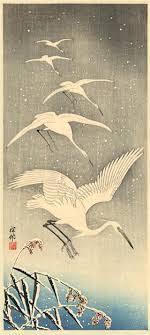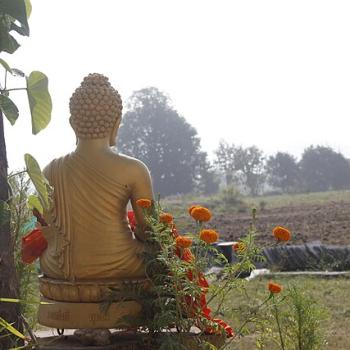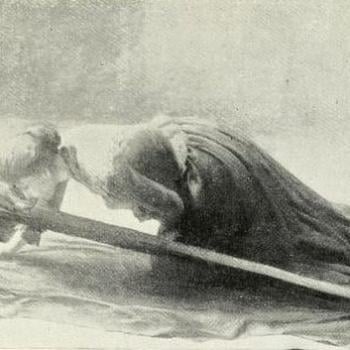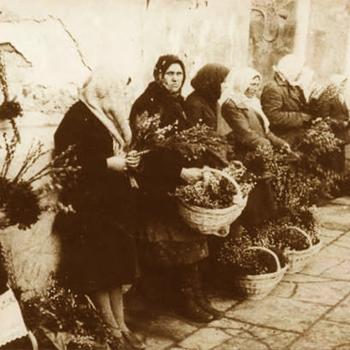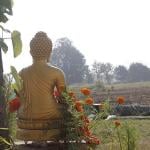The Genjo Koan
As all things are buddha-dharma, there is delusion and realization, practice, birth and death, and there are buddhas and sentient beings. As the myriad things are without an abiding self, there is no delusion, no realization, no buddha, no sentient being, no birth and death. The buddha way is, basically, leaping clear of the many of the one; thus there are birth and death, delusion and realization, sentient beings and buddhas.
Yet in attachment blossoms fall, and in aversion weeds spread. To carry yourself forward and experience myriad things is delusion. That myriad things come forth and experience themselves is awakening. Those who have great realization of delusion are buddhas; those who are greatly deluded about realization are sentient beings. Further, there are those who continue realizing beyond realization, who are in delusion throughout delusion.
When buddhas are truly buddhas they do not necessarily notice that they are buddhas. However, they are actualized buddhas, who go on actualizing buddhas. When you see forms or hear sounds fully engaging body-and-mind, you grasp things directly. Unlike things and their reflections in the mirror, and unlike the moon and its reflection in the water, when one side is illumined the other side is dark.
To study the buddha way is to study the self. To study the self is to forget the self. To forget the self is to be actualized by myriad things. When actualized by myriad things, your body and mind as well as the bodies and minds of others drop away. No trace of realization remains, and this no-trace continues endlessly.
When you first seek dharma, you imagine you are far away from its environs. But dharma is already correctly transmitted; you are immediately your original self. When you ride in a boat and watch the shore, you might assume that the shore is moving. But when you keep your eyes closely on the boat, you can see that the boat moves. Similarly, if you examine myriad things with a confused body and mind you might suppose that your mind and nature are permanent. When you practice intimately and return to where you are, it will be clear that nothing at all has unchanging self.
Firewood becomes ash, and it does not become firewood again. Yet, do not suppose that the ash is future and the firewood past. You should understand that firewood abides in the phenomenal expression of firewood, which fully includes past and future and is independent of past and future. Ash abides in the phenomenal expression of ash, which fully includes future and past. Just as firewood does not become firewood again after it is ash, you do not return to birth after death.
This being so, it is an established way in buddha-dharma to deny that birth turns into death. Accordingly, birth is understood as no-birth. It is an unshakable teaching in Buddha’s discourse that death does not turn into birth. Accordingly, death is understood as no-death.
Birth is an expression complete this moment. Death is an expression complete this moment. They are like winter and spring. You do not call winter the beginning of spring, nor summer the end of spring.
Enlightenment is like the moon reflected on the water. The moon does not get wet, nor is the water broken. Although its light is wide and great, the moon is reflected even in a puddle an inch wide. The whole moon and the entire sky are reflected in dewdrops on the grass, or even in one drop of water.
Enlightenment does not divide you, just as the moon does not break the water. You cannot hinder enlightenment, just as a drop of water does not hinder the moon in the sky. The depth of the drop is the height of the moon. Each reflection, however long of short its duration, manifests the vastness of the dewdrop, and realizes the limitlessness of the moonlight in the sky.
When dharma does not fill your whole body and mind, you think it is already sufficient. When dharma fills your body and mind, you understand that something is missing.
For example, when you sail out in a boat to the middle of an ocean where no land is in sight, and view the four directions, the ocean looks circular, and does not look any other way. But the ocean is neither round or square; its features are infinite in variety. It is like a palace. It is like a jewel. It only look circular as far as you can see at that time. All things are like this.
Though there are many features in the dusty world and the world beyond conditions, you see and understand only what your eye of practice can reach. In order to learn the nature of the myriad things, you must know that although they may look round or square, the other features of oceans and mountains are infinite in variety; whole worlds are there. It is so not only around you, but also directly beneath your feet, or in a drop of water.
A fish swims in the ocean, and no matter how far it swims there is no end to the water. A bird flies in the sky, and no matter how far it flies there is no end to the air. However, the fish and the bird have never left their elements. When their activity is large their field is large. When their need is small their field is small. Thus, each of them totally covers its full range, and each of them totally experiences its realm. If the bird leaves the air it will die at once. If the fish leaves the water it will die at once.
Know that water is life and air is life. The bird is life and the fish is life. Life must be the bird and life must be the fish.
It is possible to illustrate this with more analogies. Practice, enlightenment, and people are like this.
Now if a bird or a fish tries to reach the end of its element before moving in it, this bird or this fish will not find its way or its place. When you find your place where you are, practice occurs, actualizing the fundamental point. When you find you way at this moment, practice occurs, actualizing the fundamental point; for the place, the way, is neither large nor small, neither yours nor others’. The place, the way, has not carried over from the past and it is not merely arising now.
Accordingly, in the practice-enlightenment of the buddha way, meeting one thing is mastering it–doing one practice is practicing completely. Here is the place; here the way unfolds. The boundary of realization is not distinct, for the realization comes forth simultaneously with the mastery of buddha-dharma.
Do not suppose that what you realize becomes your knowledge and is grasped by your consciousness. Although actualized immediately, the inconceivable may not be apparent. Its appearance is beyond your knowledge. Zen master Baoche of Mt. Mayu was fanning himself. A monk approached and said, “Master, the nature of wind is permanent and there is no place it does not reach. When, then, do you fan yourself?”
“Although you understand that the nature of the wind is permanent,” Baoche replied, “you do not understand the meaning of its reaching everywhere.”
“What is the meaning of its reaching everywhere?” asked the monk again. The master just kept fanning himself. The monk bowed deeply.
The actualization of the buddha-dharma, the vital path of its correct transmission, is like this. If you say that you do not need to fan yourself because the nature of wind is permanent and you can have wind without fanning, you will understand neither permanence nor the nature of wind. The nature of wind is permanent; because of that, the wind of the buddha’s house brings for the gold of the earth and makes fragrant the cream of the long river.
(Written in mid-autumn, the first year of Tempuku 1233, and given to my (Dogen’s) lay student Koshu Yo of Kyushu Island. {Revised in} the fourth year of Kencho {I252}. Translated by Robert Aitken and Kaz Tanahashi and adapted for use in the San Francisco Zen Center.)
***
A Comment on the Koan of Everyday Life
James Ishmael Ford
I love the Genjokoan. And I love its author Eihei Dogen, the great thirteenth century Zen master and founder of Japanese Soto Zen. One can argue the Genjokoan, the Koan of Everyday Life is the summation of Master Dogen’s teachings. One could say it is the summation of Zen’s teaching.
It also offers several entry points for the student of the way. Each tantalizing, each a full presentation, each a gate. Another way to render the term Genjokoan is Actualizing the Fundamental Point. It’s all invitation.
And there are some specific invitations, as well. I think of them as nubs.
The most compelling among the nubs of the fascicle for me is:
To study the buddha way is to study the self. To study the self is to forget the self. To forget the self is to be actualized by myriad things. When actualized by myriad things, your body and mind as well as the bodies and minds of others drop away. No trace of realization remains, and this no-trace continues endlessly.
We can take it as a metaphor. And that could be rich. This essay is filled with metaphors.
Or, we can take it as a koan. The essay is called the koan of everyday life.
I’ve been rolling around the word “metaphor” in my heart and brain for a while of late. And specially how the word metaphor works with the Zen word “koan.” How they meet and how they’re different.
As often happens this past Sunday a friend gave a sermon on the subject of metaphors at the First Unitarian Church of Los Angeles where I currently consult and frequently attend. His was an invitation into the power of metaphor as a way to see larger. And he made it an invitation to people to play with those other ways of seeing things. Good sermon.
Then the concluding reading took the whole thing in a bit of a different direction.
It cited an imaginary dialogue from Gregory Bateson’s Steps to an Ecology of Mind. In the reading we were introduced to “mere metaphor” and offered an invitation instead to sacrament. Sacrament. A rich and complicated word all by itself.
In the dialogue there’s a long and involved conversation about the ballet Swan Lake. What is a swan, especially when a person is playing the swan, who also might become a person? And more, what are we really being invited into within the ballet? “Like” and “Sort of” and “pretend” and as he frames it “pretend-not” are each touched upon in Bateson’s little story.
Bateson’s point is that there is sacrament. Sacrament in the traditional Western usage of an “outward and visible signs of some inward and spiritual grace.” He points out as a for instance in the Eucharist there are some for whom the bread and wine are a metaphor. He uses the word Protestant for that view. He sees that as largely an intellectual engagement. But, for others, he uses the word Catholics, it is a sacrament. And that sacrament is of a different order than, using his word, a “mere” metaphor.
The whole dialogue is meant to take us to an understanding of an invitation to something deeper yet than a metaphor, where “the ‘pretend’ and the ‘pretend-not’ and the ‘really’ somehow get fused together into a single meaning.”
A bit heady, I find. And he wanders around a bit getting to his point. But, I do that, as well. And by the end of it, I feel he touches something.
We can look at koans that way, as well. A koan absolutely can be a metaphor. In fact it usually is. A lot of dharma talks, a lot of essays, use koans as metaphors for aspects of a spiritual life. I’ve even seen koan used as a “Zen teaching story.”
Now, I’m not especially fond of the phrase “mere metaphor.” Metaphors can be powerful teachings and of enormous help in seeing our world larger than at first it might seem. But when looking at koans as a spiritual encounter, I really get how engaging them at a metaphorical level can be called “mere.”
I will not spend a lot of time talking about koans and their history here in this brief reflection. (For a briefest introduction look here. For more, you can read this.)
But one thing I will say is that koan as a teaching story opens us to the value of metaphor.
Koan as actualizing the mystery is what we’re really being invited to.
To study the buddha way is to study the self. To study the self is to forget the self. To forget the self is to be actualized by myriad things. When actualized by myriad things, your body and mind as well as the bodies and minds of others drop away. No trace of realization remains, and this no-trace continues endlessly.
Is it a teaching story? Sure. It can be. And it can be something cutting rather closer to the bone.
What is meant when we engage words like self, especially when we hear that the self itself is actualized by the myriad things, by the world itself. What is dropping away? And what is this tracelessness that continues endlessly?
Koan is a word for this invitation. But what I want to invite here is a consideration of that word sacrament. And how sacrament might inform what we can find within the mystery of koan as a spiritual practice. And, more, how we can inform our inner lives whatever spiritual disciplines we engage.
A koan is an assertion about reality (or, you can sometimes say a reality), joined with an invitation to occupy that space.
Space is a pointing. From the outside we can take it as a metaphor. Words like stand, sit, join, see, feel, are all very good metaphors. Occupy is maybe a bit dryer, but also a metaphor. And along the way there is necessarily a consideration of who is occupying and who is being occupied. Metaphors.
And. Eventually there’s also a collapsing of who and what along with all other conceptual arts.
Here we might find ourselves encountering Dogen’s invitation.
All this very messy as we allow it to present becomes a turning toward, into the real.
So, sacrament. As a person of the Zen way I love that we’re invited with sacrament onto holy ground, to a holy moment. But we’re not, okay, we’re not merely seeing something inside of something else. Although I think that deeper intimacy is implied in the word sacrament. You need bread and wine for the sacrament of communion. We can argue water and rice, but even then there is physical matter involved. And eating, as well. Being and doing are not separate.
On the Zen way we sit down and become Buddha. Sacrament. We haul water we chop wood. Koan. We cook meals. Sacrament. We clean the bathroom. Koan.
When that inner, that other part of reality, from my perspective that aspect of the thing that opens into the wild and unnamable, is not joined, but discovered to have always been there: then we are discovering something.
A sacrament.
A koan.
The mystery revealed.


